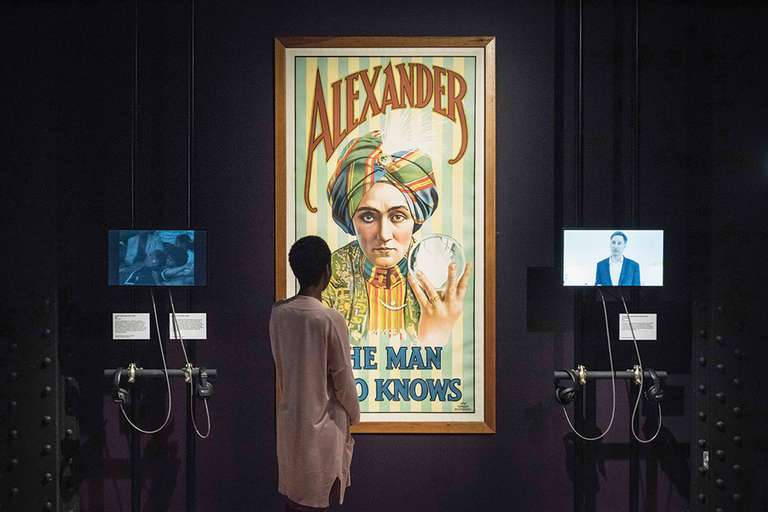
Exploring Smoke and Mirrors at Wellcome Collection for New Scientist, 1 May 2019
ACCORDING to John Nevil Maskelyne, “a bad conjurer will make a good medium any day”. He meant that, as a stage magician in 19th-century London, he had to produce successful effects night after night, while rivals who claimed their illusions were powered by the spirit world could simply blame a bad set on “unhelpful spirits”, or even on the audience’s own scepticism.
A gaffe-ridden performance in the UK by one set of spiritualists, the US Davenport Brothers, drove Maskelyne to invent his own act. With his friend, the cabinet maker George Alfred Cooke, he created an “anti-spiritualist” entertainment, at once replicating and debunking the spiritualist movement’s stock-in-trade effects.
Matthew Tompkins teases out the historical implications of Maskelyne’s story in The Spectacle of Illusion: Magic, the paranormal and the complicity of the mind (Thames & Hudson). It is a lavishly illustrated history to accompany Smoke and Mirrors, a new and intriguing exhibition at the Wellcome Collection in London.
Historical accident was partly responsible. In 1895, Guglielmo Marconi sent long-wave radio signals over a distance of a couple of kilometres, and, for decades after, hardly a year passed in which some researcher didn’t announce a new type of invisible ray. The world turned out to have aspects hidden from unaided human perception. Was it so unreasonable of people to speculate about what, or who, might lurk in those hidden corners of reality? Were they so gullible, reeling as they were from the mass killings of the first world war, to populate these invisible realms with their dead?
In 1924, the magazine Scientific American offered $2500 to any medium who could demonstrate their powers under scientific controls. The medium Mina “Margery” Crandon decided to try her hand, but she reckoned without the efforts of one Harry “Handcuff” Houdini, who eventually exposed her as a fraud.
Yet spiritualism persisted, shading off into parapsychology, quantum speculation and any number of cults. Understanding why is more the purview of a psychologist such as Gustav Kuhn, who, as well as being a major contributor to the show, offers insight into magic and magical belief in his own new book, Experiencing the Impossible (MIT Press).
Kuhn, a member of the Magic Circle, finds Maskelyne’s “anti-spiritualist” form of stage magic alive in the hands of illusionist Derren Brown. He suggests that Brown is more of a traditional magician than he lets on, dismissing the occult while he endorses mysterious psychological phenomena, mostly to do with “subconscious priming”, that, at root, are non-scientific.
Kuhn defines magic as “the experience of wonder that results from perceiving an apparently impossible event”. Definitions of what is impossible differ, and different illusions work for different people. You can even design it for animals, as a torrent of YouTube videos, based largely on Finnish magician Jose Ahonen’s “Magic for Dogs”, attest.
Tricking dogs is one thing, but why do our minds fall for magic? It was the 18th-century Scottish Enlightenment philosopher, David Hume, who argued that there is no metaphysical glue binding events, and that we only ever infer causal relationships, be they real or illusory.
Twinned with our susceptibility to wrongly infer relationships between events in the world is our ability to fool ourselves at an even deeper level. Numerous studies, including one by researcher and former magician Jay Olson and clinician Amir Raz which sits at the exit to the Wellcome show, conclude that our feeling of free will may be an essential trick of the mind.
Inferring connections makes us confident in ourselves and our abilities, and it is this confidence, this necessary delusion about the brilliance of our cognitive abilities, that lets us function… and be tricked. Even after reading both books, I defy you to see through the illusions and wonders in store at the exhibition.

